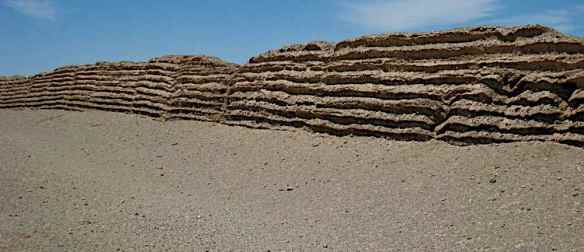The Han were an ethnically Chinese dynasty founded by a soldier who had nothing to lose as he faced execution for late arrival on parade. It was safer to rebel and bring down what was left of the Qin. The Han first emperor Gaodi (206–195 BC) inherited an exhausted state, barely able to defend itself, let alone launch into giant public works. Gaodi was reported to have ordered the restoration of the great wall but it is difficult to believe that his plan was very effective, if anything happened at all.
The early Han tried several strategies to deal with the resurgent Xiongnu who had returned to the Ordos Desert, from which Qin Shi Huang’s general Meng Tian had expelled them. The Xiongnu then occupied the Gansu Corridor. In 200 BC Gaodi led an attack on them but was ambushed by the Xiongnu leader Maodun, and suffered a complete defeat at Pincheng. There was little then that Gaodi and the early Han emperors could do except pay tribute – sometimes in the form of sending over reluctant princesses – a policy called heqin. Heqin offended Confucian moralists who were disturbed by the improper organisation of the universe, where China should be ‘first under heaven’. But responsibility for the failure of heqin did not lie only with Chinese moralists; it also eventually proved ineffective because the Xiongnu leadership were unable to control all the members of their fissiparous confederation, and this state of affairs resulted in freelance raiding.
Anyway, the early Han had both the qualities of parsimoniousness and durability sufficient to survive sixty years, long enough to replenish the treasuries and turn the tables on the Xiongnu. The later Han sought the wondrous horses of the Ferghana Valley and extended Imperial China along the Gansu Corridor. Emperor Wu (141–87 BC) started to expand the Empire and sent envoys to Central Asia to find allies against the Xiongnu. He recovered the Ordos and conquered the Gansu Corridor.
There was then a renewed campaign of wall-building to secure land retaken from the Xiongnu and to protect the Gansu Corridor to the west. It was during the Han period that China’s walls reached their greatest extent. These walls had a number of functions which were not purely defensive. They protected land that had been retaken from the Xiongnu, so they were partly aggressive in that they supported expansion. They protected the transport route that linked China to Central Asia so the Han could strike at the Western Xiongnu’s power base far from China. They defended the major trade route to Central Asia. Also, much of the eastern part of the Gansu Corridor is loess and there are oases along the route. Thus, one clear function of the walls was also to protect valued irrigated land.
The Western Han collapsed in AD 24 in a civil war which saw the destruction of the capital Xuan. The Han survived from 25 to 220 at the new capital Luoyang and the dynasty become known as the Eastern Han. Defence of Luoyang against the Xiongnu required the further construction of walls in the east.
The key issue is what had fundamentally changed, so that the Han, who had lived without walls for over a century, suddenly went in for a near orgy of wall-building? Under their reign China saw the greatest length of walls constructed – over 10,000 kilometres – at any time in its history. The reason was not initially based on a defensive mentality: rather it was to consolidate expansion at the expense of the Xiongnu, and to guarantee trade routes that extended to Central Asia. Of course, it was important to have the money to fund aggression and growth – and one reason why there was little wall building in the first half of the dynasty’s life was that the Han were refilling their coffers. Furthermore, the heqin policy worked – even if it was deemed rather shameful to Chinese sensibilities.
The Xiongnu also played their part in creating the conditions for renewed wall building. As time passed their increasing claims for brides, bribes and hospitality became less acceptable to an Empire that was recovering the power to reject such claims. Also, the inevitably loose nature of the Confederation meant that, even if agreements held at the centre, it was impossible to control outer tribes who might indulge in some independent raiding. While the Han may have been much more outward looking than many other dynasties, accommodation with barbarian nomads was still seen as demeaning – especially in the face of increasingly arrogant demands and the growing capability to wall them out.
But the process of defeating one set of nomads created its own dialectic through the emergence of another. The effective elimination of the Rong and Di by the three northern states of Yan, Zhao and Qin had provoked the emergence of the Xiongnu. The Han defeat of the Xiongnu by AD 89 meant that the way was clear for another nomad Confederation, the Xianbei, to slip into the breach. Anyway, the Han, like most dynasties, ultimately lost vitality, and the Empire broke up into ethnically Chinese not nomad-ruled states. By the early third century the Ordos was abandoned and the Han collapsed.
